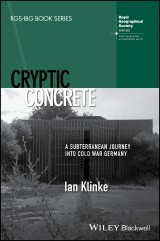Details
Cryptic Concrete
A Subterranean Journey Into Cold War GermanyRGS-IBG Book Series 1. Aufl.
|
25,99 € |
|
| Verlag: | Wiley-Blackwell |
| Format: | EPUB |
| Veröffentl.: | 14.02.2018 |
| ISBN/EAN: | 9781119261124 |
| Sprache: | englisch |
| Anzahl Seiten: | 192 |
DRM-geschütztes eBook, Sie benötigen z.B. Adobe Digital Editions und eine Adobe ID zum Lesen.
Beschreibungen
<p><i>Cryptic Concrete </i>explores bunkered sites in Cold War Germany in order to understand the inner workings of the Cold War state.</p> <ul> <li>A scholarly work that suggests a reassessment of the history of geo- and bio-politics</li> <li>Attempts to understand the material architecture that was designed to protect and take life in nuclear war</li> <li>Zooms in on two types of structures - the nuclear bunker and the atomic missile silo</li> <li>Analyzes a broad range of sources through the lens of critical theory and argues for an appreciation of the two subterranean structures’ complementary nature</li> </ul>
<p>Series Editor’s Preface vi</p> <p>Preface vii</p> <p>1 Of Blood and Soil 1</p> <p>2 Lebensraum and Its Underside 22</p> <p>3 Return to the Soil 45</p> <p>4 Nuclear Living Space 67</p> <p>5 Spaces of Extermination 91</p> <p>6 Enter the Void 111</p> <p>7 Conclusion 130</p> <p>References 142</p> <p>Index 167</p>
<p>'A serendipitous childhood discovery led the author on a personal and professional odyssey. Klinke immerses us in the zeitgeist of Cold War West Germany – a partitioned country created by post-war rivalries and foreign occupation. By investigating its subterranean qualities, he reveals a world far more complex and contradictory than accounts preoccupied with surface-level check-points and walls. Highly recommended.'<br /><b>Klaus Dodds, Department of Geography, Royal Holloway, University of London<br /></b></p> <p><i>'Cryptic Concrete </i>provides a fascinating and original exploration of how the distinctive German experiences of the Cold War and the aftermath of fascism can be read through their inscription in the architectural and landscape remains of atomic missile sites and nuclear bunkers. Ian Klinke reveals how the infrastructure of 20<sup>th</sup> century military destruction and survival informs the materiality of geopolitics in the present.'<br /><b>Rachel Woodward, School of Geography, Politics and Sociology, Newcastle University</b></p>
<p> <strong>Ian Klinke</strong> is Associate Professor in Human Geography at the University Oxford and a fellow of St John's College. His work covers German geopolitics, Cold War landscapes and the politics of European (dis)integration.
<p> 'A serendipitous childhood discovery led the author on a personal and professional odyssey. Klinke immerses us in the zeitgeist of Cold War West Germany — a partitioned country created by post-war rivalries and foreign occupation. By investigating its subterranean qualities, he reveals a world far more complex and contradictory than accounts preoccupied with surface-level check-points and walls. Highly recommended.' <br> <strong>Klaus Dodds,</strong> <em>Department of Geography, Royal Holloway, University of London</em> <p> '<em>Cryptic Concrete</em> provides a fascinating and original exploration of how the distinctive German experiences of the Cold War and the aftermath of fascism can be read through their inscription in the architectural and landscape remains of atomic missile sites and nuclear bunkers. Ian Klinke reveals how the infrastructure of 20th century military destruction and survival informs the materiality of geopolitics in the present.' <br> <strong>Rachel Woodward, </strong><em>School of Geography, Politics and Sociology, Newcastle University</em> <p> <em>Cryptic Concrete</em> sets out to understand the inner workings of the Cold War state. In an attempt to grapple with the architecture, both material and ideological, that was designed to protect and take life in nuclear war, the book examines two complimentary types of structures — the nuclear bunker and the atomic missile silo. Ian Klinke, a noted expert on German geopolitics, makes the case that West German military strategists, engineers, civil defence planners and politicians were animated in the 1950s and 1960s by the idea that geopolitics had to be fought in three-dimensional space, specifically in subterranea. Analyzing a broad range of sources through the lens of critical theory, the author reveals the ways in which the Cold War state reproduced and inverted the Third Reich's spaces of survival and extermination. In this way, <em>Cryptic Concrete</em> offers a vital reassessment of the history of geo- and bio-politics.
<p>'A serendipitous childhood discovery led the author on a personal and professional odyssey. Klinke immerses us in the zeitgeist of Cold War West Germany – a partitioned country created by post-war rivalries and foreign occupation. By investigating its subterranean qualities, he reveals a world far more complex and contradictory than accounts preoccupied with surface-level check-points and walls. Highly recommended.'<br /><b>Klaus Dodds, Department of Geography, Royal Holloway, University of London<br /></b></p> <p><i>'Cryptic Concrete </i>provides a fascinating and original exploration of how the distinctive German experiences of the Cold War and the aftermath of fascism can be read through their inscription in the architectural and landscape remains of atomic missile sites and nuclear bunkers. Ian Klinke reveals how the infrastructure of 20<sup>th</sup> century military destruction and survival informs the materiality of geopolitics in the present.'<br /><b>Rachel Woodward, School of Geography, Politics and Sociology, Newcastle University</b></p> <p><b> </b></p>


















